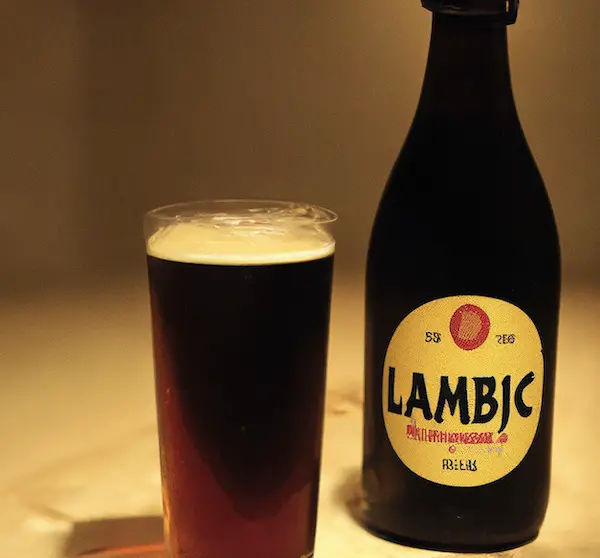Lambic beers are a unique and fascinating category of beer, known for their distinctive sour and funky flavors.
These beers are brewed using a traditional method that relies on spontaneous fermentation, which means that wild yeast and bacteria are allowed to ferment the beer rather than carefully controlled strains of brewer’s yeast.
This results in a complex, tart flavor profile that is often balanced with fruit additions or blended with other beers to create a final product that is truly unlike any other.
But with such a unique brewing process and flavor profile, many beer aficionados often wonder:
how long do lambic beers last?
In general, lambic beers can last for several years when stored properly, and some can even improve with age.
However, the exact length of time will vary depending on factors such as the specific type of lambic, storage conditions, and personal taste preferences.
The Lambic Brewing Process
To fully understand how long lambic beers can last, it’s essential to first understand the unique brewing process behind these beers. Lambic beers are brewed in the Pajottenland region of Belgium, just outside of Brussels.

The process begins with a grain bill that typically consists of around 60-70% malted barley and 30-40% unmalted wheat. This mixture is mashed and then boiled with aged hops, which are used for their preservative qualities rather than for their bittering or aroma contributions.
After boiling, the wort is transferred to a coolship, which is a large, shallow, open-air vessel that is typically housed in an attic or loft.
Here, the wort is allowed to cool overnight, during which time it is exposed to the wild yeast and bacteria that are present in the air. These microorganisms begin the fermentation process, which can take anywhere from several months to several years.
Once fermentation is complete, the lambic is either bottled straight or blended with other lambics of different ages to create a gueuze. Fruit may also be added to the lambic, resulting in a fruit lambic such as kriek (made with cherries) or framboise (made with raspberries).
The Role of Microorganisms in Lambic Aging
The unique flavors and aromas of lambic beers are primarily due to the wild yeast and bacteria that are involved in the fermentation process. Some of the most important microorganisms include:
- Saccharomyces cerevisiae: This is the most common type of yeast used in beer brewing and is responsible for converting sugar into alcohol and carbon dioxide.
- Brettanomyces: This wild yeast contributes to the characteristic funky, barnyard-like flavors and aromas that are often associated with lambic beers.
- Lactic acid bacteria: These bacteria produce lactic acid, which gives lambic beers their distinct tartness.
These microorganisms continue to evolve and develop over time, which can have a significant impact on the flavor profile of the beer. As a result, lambic beers can often improve with age, as the flavors become more complex and harmonious.
Factors That Influence the Aging Potential of Lambic Beers
There are several factors that can influence how long a lambic beer will last and whether it will improve with age. Some of the key factors include:
1.Type of lambic: Unblended lambic beers tend to be more delicate and subtle in flavor, which means they may not have the same aging potential as blended lambics (such as gueuze) or fruit lambics.
2.Alcohol content: Beers with higher alcohol content tend to age better, as the alcohol acts as a preservative. Most lambic beers have a relatively low alcohol content (around 5-6% ABV), but some can be higher.
3.Storage conditions: Like all beers, lambic beers should be stored in a cool, dark place to help preserve their flavor and prevent spoilage. This is especially important for lambic beers, as their unique flavor profiles can be highly sensitive to changes in temperature and light exposure.
4.Bottle conditioning: Many lambic beers, especially gueuzes, are bottle-conditioned, meaning that they are carbonated by the yeast in the bottle rather than being force-carbonated before bottling. This can help to extend the shelf life of the beer and contribute to the development of complex flavors over time.
5.Personal taste preferences: Ultimately, the decision of how long to age a lambic beer will come down to personal taste preferences. Some people may prefer the fresh, vibrant flavors of a young lambic, while others may enjoy the more complex and mellow flavors that develop as the beer ages.
How to Properly Store Lambic Beers for Aging
If you’re interested in aging your lambic beers, it’s important to store them properly to ensure the best possible results. Follow these guidelines for optimal storage:
1. Store the bottles in a cool, dark place, such as a basement or cellar. The ideal temperature for aging lambic beers is around 50-55°F (10-13°C).
2. Keep the bottles away from direct sunlight, as UV light can damage the beer and cause off-flavors.
3. Store the bottles upright to minimize the surface area of the beer that is exposed to oxygen, which can cause oxidation and spoilage.
4. Avoid exposing the bottles to temperature fluctuations, as this can cause the beer to expand and contract, potentially damaging the seal and allowing oxygen to enter the bottle.
5. Check the bottles periodically for signs of spoilage, such as bulging or leaking caps, off-odors, or visible mold.
Signs That a Lambic Beer Has Gone Bad
Like any other beer, lambic beers can go bad if they are not stored properly or if they have simply reached the end of their optimal shelf life. Some signs that a lambic beer may have gone bad include:
- A strong, sour, vinegar-like smell
- A change in color, such as the beer becoming darker or more cloudy
- A flat or “lifeless” taste, indicating a loss of carbonation
- An unpleasant, off-flavor that was not present when the beer was fresh
If you notice any of these signs, it’s best to discard the beer rather than attempting to drink it, as it is unlikely to be enjoyable and could potentially cause illness.
Lambic Beers and the Art of Patience
One of the most rewarding aspects of aging lambic beers is the patience and anticipation involved in the process. Unlike other types of beer that are best enjoyed fresh, lambic beers can take on new and exciting flavors as they age, making each bottle a unique and memorable experience. As a brewer and lover of lambic beers, I can personally attest to the joy and satisfaction that comes from opening a well-aged bottle and discovering the complex, harmonious flavors that have developed over time.
Personal Experiences with Aging Lambic Beers
Over the years, I have had the pleasure of aging and tasting a variety of lambic beers, from young, fresh bottles to those that have been cellared for several years. Some of my most memorable experiences include:
- Tasting a five-year-old bottle of gueuze that had developed a rich, earthy complexity and a beautifully balanced acidity.
- Comparing a fresh bottle of kriek with one that had been aged for two years, and noticing how the cherry flavors had become more integrated and the sourness had mellowed.
- Opening a bottle of unblended lambic that had been aged for three years and discovering a delicate, almost champagne-like character that was not present in the young beer.
These experiences have taught me that aging lambic beers can be a rewarding and enjoyable endeavor, but it’s important to remember that each beer will age differently and that personal taste preferences will play a significant role in determining the optimal aging time for each individual bottle.
Conclusion
In conclusion, lambic beers can last for several years when stored properly, and some can even improve with age. The exact length of time will vary depending on factors such as the specific type of lambic, storage conditions, and personal taste preferences. To ensure the best possible aging experience, it’s important to store lambic beers in a cool, dark place and to periodically check for signs of spoilage.
Here are 10 interesting facts about lambic beers and their aging potential:
1. Lambic beers are brewed using spontaneous fermentation, which relies on wild yeast and bacteria present in the air.
2. The unique flavors of lambic beers are primarily due to the microorganisms involved in the fermentation process, such as Saccharomyces cerevisiae, Brettanomyces, and lactic acid bacteria.
3. Lambic beers can often improve with age, as the flavors become more complex and harmonious.
4. Factors that influence the aging potential of lambic beers include the type of lambic, alcohol content, storage conditions, bottle conditioning, and personal taste preferences.
5. Unblended lambic beers tend to have a more delicate and subtle flavor profile, making them less suited for long-term aging compared to blended lambics or fruit lambics.
6. Ideal storage conditions for lambic beers include a cool, dark place with a temperature of around 50-55°F (10-13°C) and minimal exposure to temperature fluctuations.
7. Signs that a lambic beer has gone bad include a strong, sour, vinegar-like smell, a change in color, a flat or “lifeless” taste, or an unpleasant, off-flavor.
8. Aging lambic beers requires patience and anticipation, as the flavors can take several years to fully develop and mature.
9. Personal experiences with aging lambic beers can vary widely, as each beer will age differently and personal taste preferences will play a significant role in determining the optimal aging time.
10. Properly stored lambic beers can last for several years and can provide a unique and memorable tasting experience for those who are willing to wait.
FAQs
How long does lambic beer last after opening?
Lambic beer can last up to 3-5 days after opening if stored properly in the refrigerator. However, the taste and quality may start to deteriorate after the first day. It is best to consume lambic beer as soon as possible after opening for the best drinking experience.
How long does lambic ferment?
Lambic fermentation can take anywhere from several months to several years, depending on various factors such as the type of yeast and bacteria used, the temperature and humidity of the fermentation environment, and the desired flavor profile of the final product.
How long does it take to age a lambic?
Lambics are typically aged for at least one to three years, but some can be aged for even longer periods of time.
How do you store opened lambic beer?
Opened lambic beer should be stored in the refrigerator at a temperature between 35-45°F (2-7°C). It is also recommended to store the beer in an airtight container to prevent oxidation and loss of carbonation.
How long does Lindemans beer last?
Lindemans beer can last for several years if stored properly in a cool, dark place. However, the taste and quality may deteriorate over time, so it is best to consume within a year or two of purchase.
How do you age lambic hops?
Lambic hops are typically aged for at least three years in a cool, dry environment to develop their unique flavor and aroma characteristics.




